Domestic Violence Defined
Domestic violence is defined as violent behavior against a family member, or other violence taking place within a home.3 Child abuse, spousal/partner abuse, and elder abuse are included in this definition. Although not always obvious, DV is an epidemic that affects individuals in every community4 and occurs in every population regardless of race, ethnicity, class, sexual orientation, gender identity, religious affiliation, age, or income level.2 Although child, elder, and partner abuse are all problems that dentists may encounter, partner/spousal abuse is the most common.3 Intimate partner violence (IPV) is violent behavior occurring within an intimate partner relationship.5 In the past violence toward women was tolerated by society and even supported. Now, the legal system views violence more seriously. For instance, most states have established laws that designate state health care professionals, including dentists, as mandated reporters of these acts.5
Both men and women can be victims of DV; however, approximately 85% of DV victims are women (see Fig. 30-1).67 Data indicate that more than 1 million women and 150,000 men are victims of DV each year in the United States,8–11 with 20% to 30% of women and 7.5% of men having been abused by a partner.12,13 One in every four women will experience domestic violence in her lifetime.14 Women of all ages are at risk for domestic and sexual violence, and those 20 to 24 years of age are at the greatest risk of experiencing nonfatal IPV.15
Because of the high rates of IPV toward women, health care providers have established the term battered woman syndrome to describe it— a “symptom complex occurring as a result of abusive actions directed against a woman by her male partner.”3 Power and control issues pervade the relationships between battered women and their abusers (Fig. 30-2). Most abusive partners of battered women deliver severe and frequent abuse resulting in a wide variety of physical injuries.2 Perpetrators are likely jealous and possessive and desire absolute and complete knowledge of everything about their partners. Drug and alcohol use are common among batterers and they commit violence to assert control over their partners. Attempts are usually made by the victim to minimize the violence, but the battered individual is unable to appease the partner.16
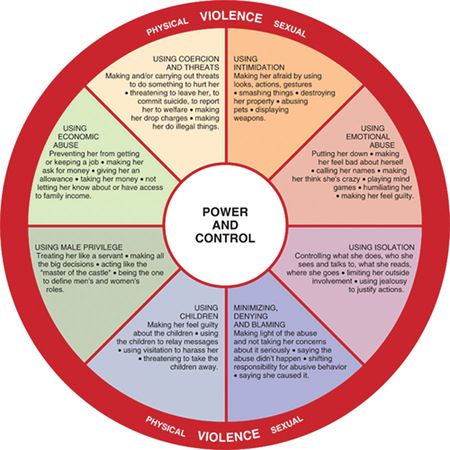
Victims of abuse suffer more than physical consequences. There can be long-term psychologic effects, including low self-esteem and feelings of inadequacy.16 Battering episodes are estimated to account for one-third of all female suicide attempts.5 Health problems appear frequently in IPV victims.2 These women are 80% more likely to suffer a stroke, 70% more likely to have heart disease, 60% more likely to have asthma, and 70% more likely to abuse alcohol than women who have not experienced IPV.17
Dental Assessment of Domestic Violence
Despite the widespread nature of DV and the negative consequences resulting from it, most DV situations are never reported to the police.18 Some IPV victims only seek health care from their dentist and avoid other health care professionals. According to a 1998 national survey, 9.2% of the women who sought health care for physical assault by an intimate partner visited a dentist.19 Unfortunately, data shows that the recognition and reporting rates for IPV are substantially lower than the actual prevalence. Records indicate that dentists report less than 1% of these cases.5 Low reporting rates have been attributed to health care professionals’ lack of knowledge of the problem and its manifestations, ambiguous reports from victims, and practitioners’ inattention or distraction.5 Dentists can improve their ability to prevent ongoing abuse associated with DV by learning to recognize the signs and symptoms.
Approximately two-thirds of all adults in the United States have an annually scheduled dental consultation,19, 20 in which a routine dental examination involving an inspection of the head, neck, and oral cavity may reveal signs of abuse19, 21 (Fig. 30-3; also see Fig. 30-1).
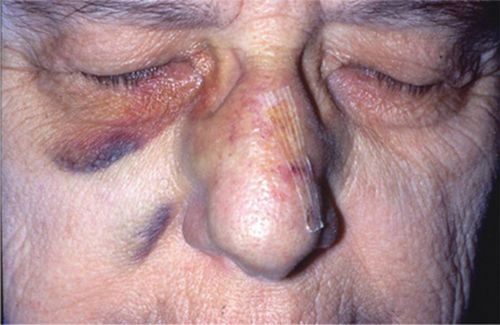
In a study conducted in Brazil, IPV was the third most common cause of traumatic dental injury, after domestic accidents and sporting activities. In this study of 7750 police-recorded physical violence reports, 2% were traumatic dental injuries caused by IPV (22 injuries). The most frequently injured teeth were the maxillary incisors, followed by the mandibular incisors and then the maxillary canines. The reports indicated that 59.1% of the teeth were fractured, 27.2% were luxated, and 13.7% were avulsed.22 In another study including 85 IPV cases, 14% exhibited neck injuries, 21% had facial injuries, 29% suffered lip injuries, 5% reported tongue trauma, 5% lost teeth, 7% had a fractured jaw, and 3% reported other injuries.23
Evidence of violence may be detected in a number of areas, including the oral and perioral structures, through lip trauma, fractured or subluxated teeth, fractures of the mandible or maxilla, or severe bruising of the edentulous ridges (Figs. 30-4 and 30-5).24
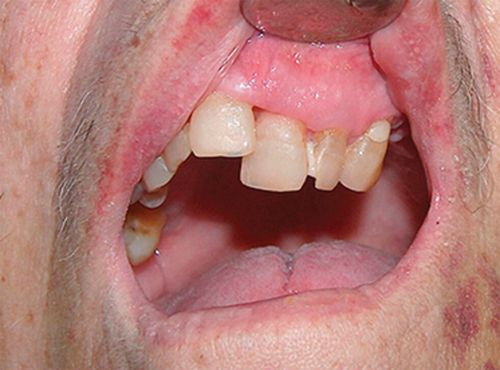
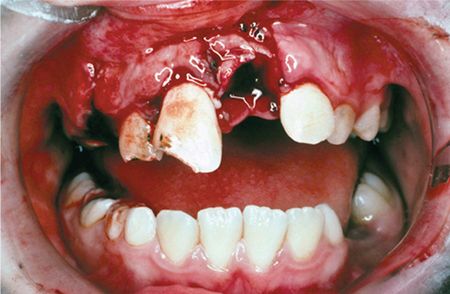
Indicators of prior trauma may be detected through fractures to the zygomaticomaxillary complex, eye injuries, orbital fractures and facial tissue bruising.19, 25 If a battered woman is presenting to the dental office for treatment of maxillofacial injuries, it is likely that the violence has occurred over a long period of time.5
In addition to screening adults (often women) for IPV, it is vital that dentists also evaluate for signs of abuse when working with children and elderly patients. Most states have laws outlining the obligations of mandated reporters, stating that a report should be made for any child suspected of being a victim of abuse or neglect.19,26 More than half of physically abused children have sustained a head and/or neck injury. These areas are often visible to a perceptive dentist.19, 27 Signs of abuse can include oral and perioral injuries, tearing of the frena, isolated laceration of the soft palate, multiple fractured, discolored, nonvital or avulsed anterior teeth (see Fig. 30-6) and odd malocclusions or different levels of occlusions (nonreduced old jaw fractures). Gag marks evident in commissural abrasions/contusions may be present. Circular bruises on both sides of the lower face from grab marks, parallel contusions running diagonally across the face from slap marks (Fig. 30-6) bruises on the ears, or bite marks are also indicators. Finally, oral lesions from sexually transmitted diseases may be detected (Fig. 30-7).28
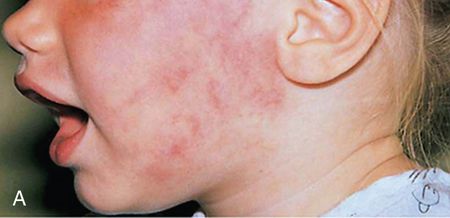
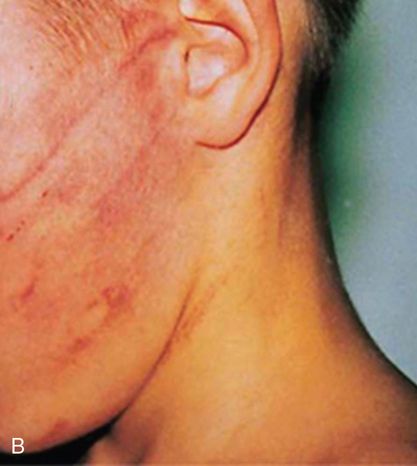
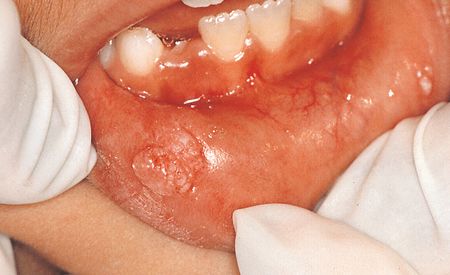
Legal Issues for Dentists
Dentists have a legal responsibility to report child abuse. All fifty states, and the District of Columbia, have enacted laws that require the reporting of suspected child abuse.28
Stay updated, free dental videos. Join our Telegram channel

VIDEdental - Online dental courses


